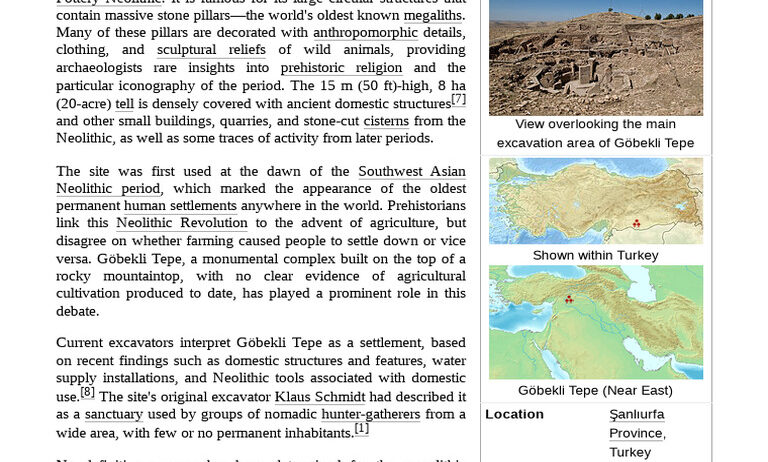Göbekli Tepe, an archaeological marvel located in southeastern Turkey, stands as a testament to the ingenuity and ambition of early human societies. This ancient site, often dubbed the world’s first temple, was erected during a time when humanity was transitioning from hunter-gatherer lifestyles to settled agricultural practices. Yet, in order to understand its significance, one must first explore the climate that enveloped this enigmatic location during its time of use.
Amidst the rolling hills and expansive plains of what is now Turkey, the climate during the late Pleistocene and early Holocene epochs was anything but static. The environment fluctuated wildly, shaping the very existence of the peoples who lived there. Imagine a vast expanse where the seasons danced in unpredictable harmony, with the sun’s warmth lacing through verdant meadows that birthed life anew each spring. This region, once cloaked in a diverse tapestry of flora and fauna, would play a crucial role in influencing the establishment of Göbekli Tepe.
In understanding the climate of Göbekli Tepe, one must conjure vivid images of a world that was both bounteous and harsh. The weather featured a concoction of semi-arid conditions, punctuated by periods of occasional rainfall which transformed the arid surroundings into a lush paradise, supporting various herbivorous species. The fauna that thrived in these conditions included wild boars, deer, and gazelles, all of which were integral to the diets of early humans. This semi-arid expanse, with its tantalizing shifts between drought and ephemeral greenery, created a complex ecosystem ripe for transformation.
Moreover, it is not merely the average temperatures or rainfall patterns that shape a climate’s identity, but rather the stories those conditions enkindle. Just as a painter selects hues to evoke emotion on a canvas, the early inhabitants of Göbekli Tepe chose their responses to climatic cues with unprecedented creativity and resilience. Adapting to the undulating rhythms of climate changed the very fabric of their society.
As the Ice Age waned, the region of Göbekli Tepe began to witness a significant increase in moisture. This gradual metamorphosis heralded a marked shift in vegetation, leading to the proliferation of wild cereals and edible plants. The bountiful harvests of this nascent agricultural era beckoned communities to adopt a more sedentary lifestyle, culminating in the monumental construction of Göbekli Tepe about 9600 BCE. Its construction was not merely a reflection of spiritual pursuits, but also of the societal transformation spurred by climate-induced agricultural abundance.
However, the image of an idyllic climate must be tempered with the understanding of its capricious nature. The inhabitants of Göbekli Tepe were no strangers to climatic fluctuations; periods of drought would intersperse the lush intervals, challenging their nascent agricultural practices. Just as a river can suddenly swell with rain, so too would the challenges of scarcity drive innovation and adaptation. This constant push and pull of availability and climate echoed the very essence of survival in the region.
To fully appreciate Göbekli Tepe is to recognize the resilience of those who toiled to erect its magnificent stone pillars amidst the unpredictable whims of nature. The symbolic pillars, adorned with intricate carvings of animals and mythical beings, stood not only as religious manifestations but also as markers of triumph over environmental challenges. They signify not just the human spirit’s capacity for perseverance, but the very dialogue between human ingenuity and the climate’s whims.
While today’s world grapples with climate change, the climate of Göbekli Tepe can offer poignant lessons on resilience and adaptation. The ability of its inhabitants to navigate through environmental challenges mirrors modern struggles as societies around the globe face the impacts of climate volatility. One must ponder how much of our contemporary world’s reliance on agricultural stability echoes the events that unfolded millennia ago in this historic sanctuary.
Furthermore, scientists and archaeologists now delve deep beneath the surface of Göbekli Tepe, unearthing the pivotal role played by the paleoenvironment in shaping human history. Understanding the intricacies of the local climate through sediment analysis and ancient pollen grains reveals the delicate interplay between humans and nature, painting a picture of resilience and adaptation that transcends time.
In conclusion, the climate of Göbekli Tepe is a vivid tapestry interwoven with the complexity of human adaptation. The lush, fertile soils, conducive to agriculture and the symbolic construction of monumental architecture, embody the profound impact that climate can exert on human societies. As researchers sift through the remnants of ancient life at this archaeological site, they unravel the intricate web of interactions that reveal not just the climate, but also a narrative of survival, innovation, and spiritual expression. Looking back, the climate of Göbekli Tepe resonates as an echo of humanity’s eternal quest to harmonize with the environment, a pursuit as vital today as it was thousands of years ago.







